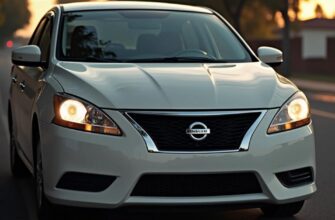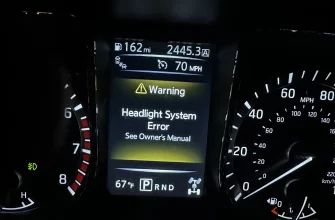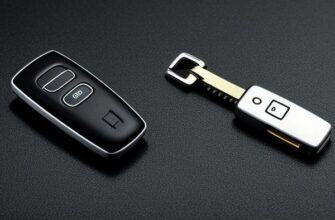Driving your Nissan Rogue, relying on its modern features and smooth ride, when suddenly a generic “Malfunction” message pops up on your dashboard display. It doesn’t tell you what is malfunctioning, just that something is wrong. Frustrating, right? This vague message can certainly cause a pang of worry – is it safe to drive? Is it something serious?
If you’re a Nissan Rogue owner and have encountered this message, you’re not alone. While it’s not the most informative alert, it’s your vehicle’s way of telling you that one of its many computer-controlled systems has detected an issue. The key is figuring out which system is the unhappy one!
Let’s break down what this generic “Malfunction” message could mean in your Nissan Rogue and guide you through the steps to pinpoint the problem.

What Does a Generic “Malfunction” Message Actually Mean?
Think of the “Malfunction” message as your Nissan Rogue’s central computer saying, “Hey, something isn’t working correctly in one of my many linked systems!” It’s a high-level alert that there’s a Diagnostic Trouble Code (DTC) stored in one of the vehicle’s control modules, but the system displaying the message (like the instrument cluster) isn’t giving you the specific details upfront.
It’s a Symptom, Not the Diagnosis
The message itself isn’t the problem; it’s a symptom that points to a problem elsewhere. It’s like a generic error message on your computer saying “An error occurred” without telling you which program crashed or why.
Why So Vague?
Modern cars like the Rogue have dozens of interconnected computer modules controlling everything from the engine and transmission to the airbags and driver-assist features. A generic “Malfunction” message is often used when the issue isn’t a standard engine or transmission code (which might trigger the Check Engine Light) but relates to another complex system that’s detected a fault.
Common Systems That Trigger “Malfunction” in the Nissan Rogue
Based on our experience and reports from other owners, certain systems in the Nissan Rogue are more likely to trigger a generic “Malfunction” message when they encounter an issue.
Chassis Control System
The Chassis Control system in the Rogue integrates several functions related to driving dynamics and safety, including:
- Anti-lock Braking System (ABS)
- Traction Control System (TCS)
- Vehicle Dynamic Control (VDC / Stability Control)
- Active Ride Control, Active Engine Brake, Active Trace Control
Problems with wheel speed sensors (often linked to ABS/TCS/VDC), yaw sensors, steering angle sensors, or even a voltage issue can cause this system to fault and display a “Malfunction” message. We have a detailed guide on Explaining the Nissan Rogue Chassis Control System Error if you suspect this might be the area of concern. Relatedly, issues with the traction or stability control system can sometimes trigger specific lights, as discussed in What Does the Slip Light Mean on Your Nissan.
Driver-Assist Systems (FEB, BSW, LDW, etc.)
Many modern Rogues are equipped with advanced driver-assist features like Forward Emergency Braking (FEB), Blind Spot Warning (BSW), Lane Departure Warning (LDW), Rear Cross Traffic Alert, etc. These systems rely heavily on external sensors (radar in the bumper, cameras on the windshield/mirrors).
- Sensor Blockage: Snow, ice, mud, dirt, or even a car wash can temporarily block a sensor’s view, causing the system to become unavailable and display a “Malfunction” message.
- Sensor Misalignment or Damage: A minor bump or impact can misalign a radar unit or camera, requiring recalibration or replacement.
- System Glitches: Like any electronics, the control modules for these systems can sometimes experience software glitches.
“Got a ‘Malfunction’ message on my Rogue during a snowstorm. Cleared up the radar sensor in the front bumper and the camera on the windshield, and the message went away after a restart. Scared me for a bit though!” – Emily K., Faced Winter Weather
Key System / Intelligent Key
Issues related to the vehicle’s keyless entry and starting system can sometimes trigger a generic malfunction message, although they often come with more specific key-related warnings too. Problems could involve the key fob battery, the car’s receiving antennas, or the system’s control module. Learn more about Understanding and Resolving Error Keyless System in Your Nissan.
TPMS (Tire Pressure Monitoring System)
While the TPMS usually has its own specific warning light, a fault within the TPMS control module itself or a communication error could potentially trigger a more generic malfunction message in some cases. Our guide on Fixing TPMS Errors in Your Nissan covers common TPMS issues.
Headlight System
In some Nissan Rogue models, issues with the automatic headlight system, high beam assist, or related sensors can trigger a specific “Headlight System Error” that might be interpreted by the main display as a generic malfunction. We have a dedicated post on Nissan Rogue Headlight System Error Causes and Fixes that delves into this.
Other Systems
Less commonly, issues with the Electronic Parking Brake, Airbag System (though usually triggers a dedicated airbag light), or other electronic control modules could potentially cause a generic malfunction message.
“My Rogue dashboard just said ‘Malfunction’ with no other lights initially. Took it to my mechanic, and they read the codes. It was related to a faulty wheel speed sensor causing the Chassis Control system to fault.” – James P., Got It Diagnosed
Accompanying Symptoms & What Else to Look For
A generic “Malfunction” message is rarely the only symptom. Pay attention to what else is happening:
- Are Other Warning Lights On? Is the Check Engine Light, ABS light, VDC light, Airbag light, or any other icon illuminated along with the “Malfunction” message? This is a huge clue!
- Are There Driving Symptoms? Does the car feel different? (e.g., loss of power, strange braking behavior, steering feels off, rough idling, car shaking).
- When Does the Message Appear? On startup? While driving? After hitting a bump? Only in certain weather conditions? Intermittently?
- Did Anything Happen Just Before? (e.g., Drove through deep water, hit a pothole, had service done).
The context surrounding the message is crucial for diagnosis.
Troubleshooting Steps: What You Can Try First
While a diagnostic scan is the ultimate answer, here are a few simple things you can check or try yourself:
1. Note All Warning Lights & Symptoms
Take a picture of your dashboard if possible. Write down exactly what the message says and any other lights that are on. Note any driving symptoms.
2. Check & Clean External Sensors
Inspect the front bumper/grille area for the radar sensor (often a plastic panel) and the top of the windshield for the camera (behind the rearview mirror). Clean off any dirt, snow, or debris.
3. Check Tire Pressure
Ensure all tires are properly inflated, including the spare if your system monitors it. A TPMS issue is a possibility.
4. Perform a Simple Reset
Sometimes, turning the car completely off, opening the driver’s door (to ensure systems power down), closing the door, waiting a few minutes, and then restarting the vehicle can clear temporary electronic glitches.
5. Consult Your Owner’s Manual
Your owner’s manual may have a section explaining dashboard messages and what actions to take for general warnings or specific system alerts.
6. Get Diagnostic Codes Read (CRUCIAL!)
This is the single most important step. A generic “Malfunction” message always means there’s one or more specific trouble codes stored in one of the car’s computers. Taking your Rogue to an auto parts store that offers free code reading or using your own OBD-II scanner (if it can read non-powertrain codes) will give you the specific code (e.g., C1A00, B2551, U0401). This code is the key to identifying which system is malfunctioning.
“Got the ‘Malfunction’ message and the car felt a bit sluggish, like it was in limp mode. Scan showed codes related to the Chassis Control System. Ended up being a bad ABS sensor.” – Chloe R., Figured It Out
Feeling like your car is limited on power can indeed feel like limp mode. Our guide on How to Get Your Car Out of Limp Mode provides general context on restricted performance modes.
When to Seek Professional Help
If the “Malfunction” message is persistent, accompanied by other warning lights, or if you experience driving symptoms, professional help is necessary.
- If getting the codes read reveals complex codes you don’t understand.
- If the message comes back immediately after clearing codes or performing resets.
- If there are noticeable issues with braking, acceleration, steering, or vehicle stability.
- If the message is related to safety-critical systems like airbags or brakes.
Nissan vehicles often require specialized diagnostic tools (like the Nissan Consult system) to fully diagnose issues in complex body or chassis control modules. A qualified mechanic familiar with Nissans will be able to accurately interpret codes and perform necessary testing or repairs.
For more model-specific troubleshooting or to connect with other owners, check out dedicated Nissan Rogue forums online. You can also consult a reputable repair manual specifically for your Rogue’s model year for detailed system information. (Mentioning types of external resources).
Frequently Asked Questions (FAQ)
Q: Is a “Malfunction” message always serious?
A: Not always, but it should never be ignored. It could be something as simple as a temporarily blocked sensor, or it could indicate a more significant issue with a safety-critical system. Diagnosis is required to know the severity.
Q: Can I still drive my Nissan Rogue if it says “Malfunction”?
A: It depends on what system is malfunctioning. If the message is generic and there are no other warning lights and no noticeable driving symptoms (brakes feel normal, steering is fine, no power loss), you might be able to drive a short distance cautiously. However, if other lights like ABS, Brake, or Check Engine are on, or if the car drives strangely, it is safer to avoid driving and get it towed to a repair shop.
Q: Will disconnecting the battery clear the “Malfunction” message?
A: Disconnecting the battery may temporarily clear the message by resetting the control module. However, it does not fix the underlying problem, and the message is likely to return once the system detects the fault again.
Q: How do I find out which system is malfunctioning?
A: The only reliable way is to use a diagnostic scan tool to read the specific trouble code(s) stored in the vehicle’s computer modules. This code will point directly to the system or component that reported the fault.
Q: Why does the Nissan Rogue seem to have a lot of these “Malfunction” messages?
A: Modern vehicles like the Rogue rely heavily on interconnected electronic systems and sensors for features like driver assistance, stability control, and comfort. More complexity means more potential points of failure or miscommunication that can trigger a generic alert when a specific fault code is set. Some generations or specific systems within the Rogue (like the Chassis Control or FEB) have been more prone to certain issues than others.
Conclusion
A “Malfunction” message on your Nissan Rogue’s dashboard is a generic alert indicating a problem in one of the vehicle’s systems. While it doesn’t tell you the specific issue, it’s a clear sign that a diagnostic trouble code has been set. Common culprits often involve the Chassis Control system, driver-assist features, or key system. The crucial next step is always to get the diagnostic codes read to understand exactly which system is reporting the malfunction. Don’t ignore this message – a prompt diagnosis will ensure your Rogue is operating safely and correctly.







